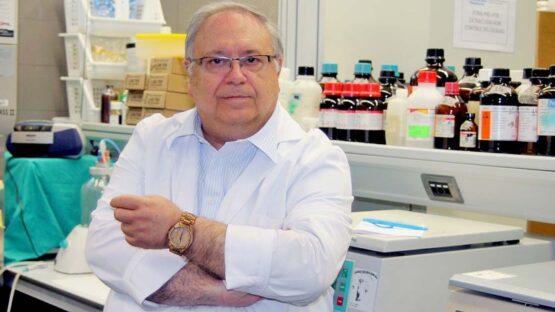
Dr. Jesús Vaquero Crespo, holder of the Chair of Neuroscience of the Rafael del Pino Foundation, passes away
In the difficult days we are living through, we deeply feel the passing of those close to us and the people we hold dear, but in the case of Dr. Jesús Vaquero Crespo, this is coupled with enormous admiration for his kindness and personal humility and professional excellence. We have lost an exemplary life, which Dr. Vaquero dedicated to research and to the care of his fellow citizens. From the Rafael del Pino Foundation we would like to acknowledge his effort and dedication to the noble task of healthcare. May he rest in peace
Dr. Jesús Vaquero Crespo was one of the world leaders in the field of cell therapy research aimed at neurological deterioration, essentially in the treatment of spinal cord injury, but with solid ramifications in other neurological pathologies. A specialist in Neurosurgery and Neurology, he was Professor at the Autonomous University of Madrid and head of the Neurosurgery Department at the Puerta de Hierro-Majadahonda University Hospital in Madrid.
The result of their research has meant a paradigm shift and has led to the design of the first human cell therapy drug, recently approved by the Spanish Medicines Agency, as the first advanced therapy drug for non-industrial manufacture that has been shown to alleviate the serious consequences of spinal cord injury with the corresponding improvements in the quality of life of people with spinal cord injuries. The first results of the research carried out are convincing: the people included in its clinical trials have achieved sphincter control, skin sensitivity to touch and temperature and have regained some of their lost mobility.
In addition to spinal cord injury, the cell technology developed by Dr. Vaquero is showing its capacity to treat other neurological pathologies that have so far lacked effective treatment and are so prevalent, such as the chronically established sequelae of traumatic brain injury, with 2 million people affected worldwide, cerebral stroke, which affects more than 4 million people annually, or Alzheimer's disease, with 90 million people affected, as well as other dementias in whose physiopathology the reduction of brain metabolism plays a decisive role.
Dr. Vaquero was a founding, active or honorary member of 26 scientific societies, including the Congress of Neurological Surgeons, the American Association of Neuropathologists, the International Society of Neuropathology, the Societé Française de Neurologie, the Societé de Neurochirurgie de Langue Française, the Sociedad Iberoamericana de Ciencias Neurológicas, the European Federation of Neurological Societies, the World Federation of Neurosurgical Societies and the World Federation of Neurology.
He was the author of more than 720 publications, mostly in international indexed scientific journals, more than 100 in the first quartile or decile, and was among the Spanish clinicians with the highest number of scientific citations. The impact factor accumulated by Dr. Vaquero throughout his prolific research life was over 750 and the H index was 41. He received more than 60 Spanish and international research awards, including the following: Queen Sofia Award for Rehabilitation and Integration 2011 from the Royal Board on Disability; CERMI Award 2014; ASPAYM National Award 2015; Health Excellence Award 2016 from the European Institute of Health and Social Welfare; and the Queen Letizia Award for Disability Prevention 2016 from the Royal Board on Disability.
Dr. Vaquero, together with his wife, Dr. Mercedes Zurita, and their team at the Autonomous University of Madrid and the Puerta de Hierro Hospital in Madrid, started a promising path in the treatment of neurological pathologies that had never been thought to be so close and opened a window to the world of neurological recovery for millions of people.
Curriculum vitae
Born in Madrid in 1950. University lecturer for over 40 years. Degree in Medicine and Surgery from the Complutense University (1967-1974). Degree of Doctor with distinction cum laude, in 1977. Trained as a specialist in Neurosurgery at the Hospital Universitario Puerta de Hierro (1974-1978). Head of Section of the Neurosurgery Service at the Hospital Puerta de Hierro-Majadahonda. Responsible as Chief Surgeon or supervisor for more than 4,000 neurosurgical operations.
- Master's Degree in Medical Management and Management of Clinical Units. Expert in Clinical Management from the UNED. University Professor since 1993. Currently, Director of the Department of Surgery at the Universidad Autónoma de Madrid and Professor of Neurosurgery, with a post at the Hospital Universitario Puerta de Hierro-Majadahonda.
- Director of the Neurosciences Research Unit at Puerta de Hierro-Majadahonda Hospital and Director of the Neurosciences Area of the Institute of Biosanitary Research at the same Hospital. Director of the UAM-Instituto de Neurociencias Hospital Los Madroños Sponsorship Chairs for research in Brain and Spinal Cord Injury, UAM-Sermes for Research in Neurological Disability, UAM-Fundación Mapfre for research in Brain Injury and Rafael del Pino for Research in Neurosciences.
- Founding, active or Honorary Member of 26 Scientific Societies, including the Congress of Neurological Surgeons, American Association of Neuropathologists, International Society of Neuropathology, Société Française de Neurologie, Société de Neurochirurgie de Langue Française, Sociedad Iberoamericana de Ciencias Neurológicas, European Federation of Neurological Societies, World Federation of Neurosurgical Societies and World Federation of Neurology. Member of the Royal Academies of Medicine of Valencia, Granada, Cadiz, Valladolid, Murcia, Seville and Galicia.
- Director of more than 30 Doctoral Theses. Author or coordinator of 23 textbooks and 70 chapters in as many textbooks on clinical medicine or research in the field of neuroscience. Author of more than 700 publications, most of which correspond to articles in indexed scientific journals, mostly international. Author of more than 500 communications, invited lectures and presentations at conferences. Participation as collaborator or Principal Investigator in more than 80 Research Projects financed by public or private organisations.
- 53 national and international research awards, including the Queen Sofia Award for Rehabilitation and Integration, granted by the Royal Board on Disability (2011) for the Cell Therapy Research line for patients with spinal cord injury and other neurological disabilities, the CERMI Award (2014) for the development of the Clinical Cell Therapy Programme for patients with disabilities, the Caser Award for R&D Research in Dependency (2014) and the Aspaym National Award for clinical research into spinal cord injury (2015).
- Cumulative Impact Factor of over 700 and H Index of 36, with nearly 5,000 citations in the international literature. Accreditation of 6 Sexenios of research.
- Member of numerous National and Regional Research Assessment Agencies, including the National Commission for the Accreditation of University Teaching Staff (ANECA Academy Programme).
- He has organised and directed more than 120 Courses and Seminars and has received more than 120 Grants and Research Grants for the development of the lines developed in the Neurosciences Research Unit of the Hospital Universitario Puerta de Hierro-Majadahonda.
- Throughout his scientific and medical career, Dr Vaquero has focused on the study of prognostic markers in brain tumours and the development of new cell therapy techniques applied to neurological diseases. His group was the first to apply immunomodulatory cell therapy with NK cells in brain gliomas (1987-1990) or to perform chromaffin cell transplants in patients with pain refractory to conventional treatment (1988). In the last 20 years, he has directed a clinical research programme aimed at studying the possibilities offered by new cell therapy techniques to alleviate the disability of patients with neurological injuries. As a result of these studies, his group has developed the first human cell therapy drug approved by the Spanish Agency for Medicines and Health Products, which is already being applied in three clinical trials, being the first authorised in Spain for the treatment of patients with chronically established traumatic paraplegia.


